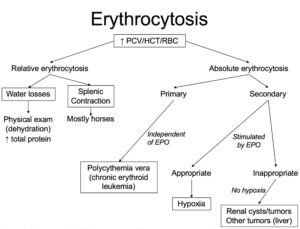Erythrocytosis (or more specifically erythrocythemia, although no-one uses the latter term) is usually recognized by an increased packed cell volume (PCV) or hematocrit (HCT) although in reality erythrocytosis means an increased red blood cell count. The term erythrocytosis is often used interchangeably with polycythemia, although this is not 100% accurate. Erythrocytosis can be relative (more common) or absolute. Relative erythrocytosis due to dehydration or hemoconcentration will be accompanied by an increased total protein (both globulins and albumin), whereas the other types of erythrocytosis may not have increased protein levels. Absolute erythrocytosis (true increase in RBC mass) can be due to a primary bone marrow disorder (the erythropoiesis is largely independent of erythropoietin [EPO] concentrations), specifically polycythemia vera (chronic erythroid leukemia), or secondary to hypoxia (appropriate) or EPO-producing neoplasms (mostly in kidney but also in liver) or renal disorders (e.g. cystic kidneys) (inappropriate).

